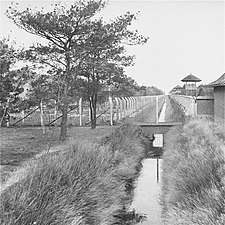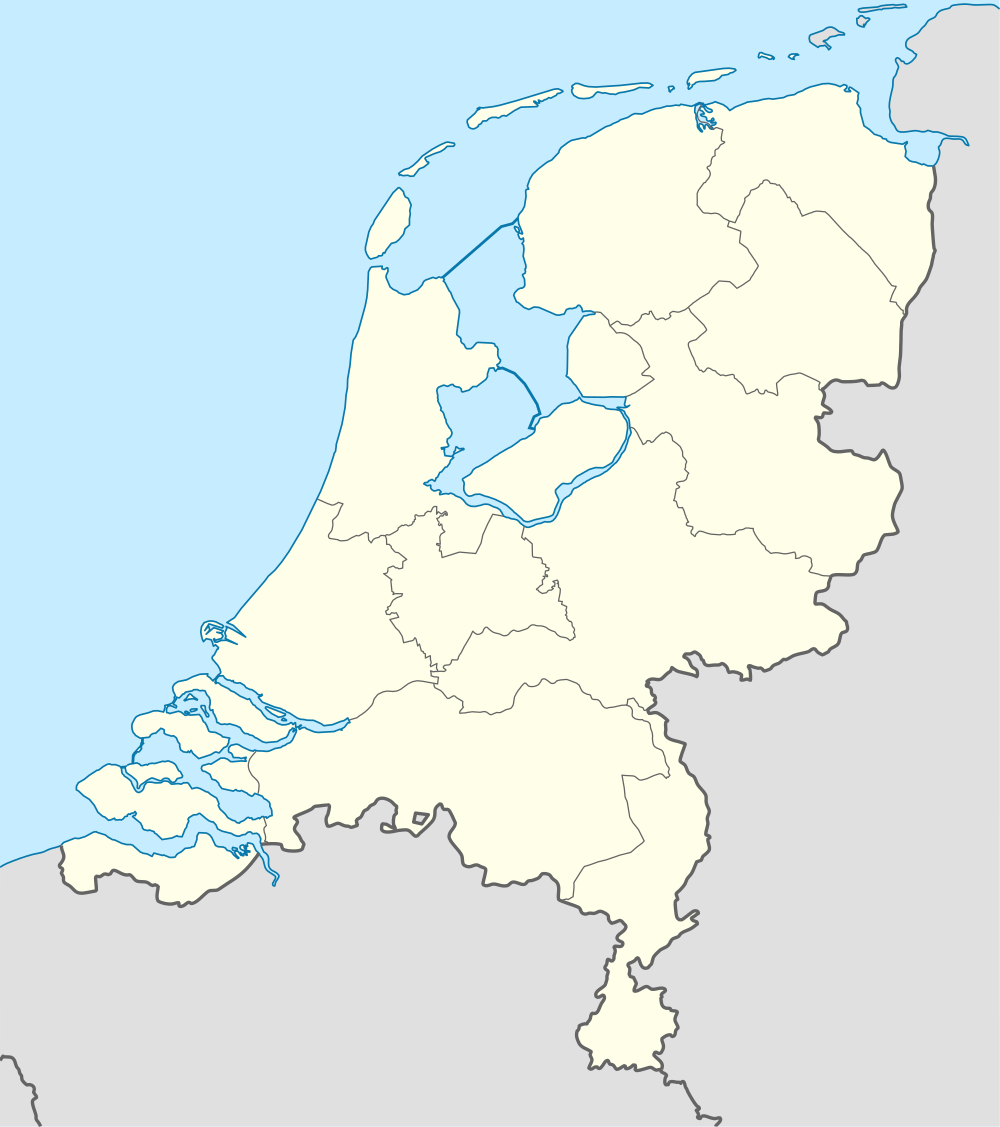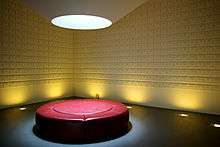Herzogenbusch concentration camp
Herzogenbusch was a Nazi concentration camp located in Vught near the town of 's-Hertogenbosch, Netherlands. The camp was opened in 1943 and held 31,000 prisoners. 749 prisoners died in the camp, and the others were transferred to other camps shortly before the camp was liberated by the Allied Forces in 1944. After the war the camp was used as a prison for Germans and Dutch collaborators. Today there is a visitors' centre with exhibitions and the memorial Nationaal Monument Kamp Vught remembering the camp and its victims.
| Herzogenbusch | |
|---|---|
| Nazi concentration camp | |
 Fence of the camp, 1945 | |
 Location of the camp in the Netherlands | |
| Other names | Dutch: Kamp Vught, pronounced [kɑmp ˈfɵxt], German: Konzentrationslager Herzogenbusch [kɔntsɛntʁaˈtsi̯oːnsˌlaːɡɐ hɛʁtsoːɡənˈbʊʃ] |
| Location | Vught, Netherlands |
| Built by | Nazi Germany |
| Operated by | SS |
| Commandant |
|
| First built | 1942 |
| Operational | January 1943 26 October 1944 |
| Inmates | Jews, Gypsies political prisoners |
| Killed | 749 |
| Liberated by | 4th Canadian Armored Division 96th Battery of the 5th Anti-Tank Division |
| Notable inmates | Anton Constandse, Helga Deen, David Koker |
| Website | www |

History
During World War II, Nazi Germany occupied Netherlands (1940–1945). In 1942 the Nazis transported Jewish and other prisoners from the Netherlands via the transit camps Amersfoort and Westerbork to the Auschwitz concentration camp, except for 850 prisoners sent to Mauthausen concentration camp.[1] When Amersfoort and Westerbork appeared to be too small to handle the large number of prisoners, the Schutzstaffel (SS) decided to build a concentration camp in Vught near the town of 's-Hertogenbosch.[2]
The building of the camp at Herzogenbusch, the German name for 's-Hertogenbosch, started in 1942.[2] The camp was modelled on concentration camps in Germany. The first prisoners, who arrived in 1943, had to finish the construction of the camp; it was used from January 1943 until September 1944. During this period, it held nearly 31,000 prisoners: Jews, political prisoners, resistance fighters, Gypsies, Jehovah’s Witnesses, homosexuals, homeless people, black market traders, criminals, and hostages.
Due to hunger, sickness, and abuse, at least 749 men, women and children died there. Of these, 329 were murdered at the execution site just outside the camp. As allied forces approached Herzogenbusch, the camp was evacuated and the prisoners were transferred to concentration camps further east, with women inmates being transferred to Ravensbrück Concentration Camp, and the men to Sachsenhausen concentration camp by 4–5 September 1944.[3] On 26 October 1944, Scottish troops of the 7th Black Watch and Canadian troops of the 4th Canadian Armoured Division's 96th Battery, 5th Anti-tank Regiment liberated the camp after fighting a rear guard of SS guards left to defend the nearly evacuated camp.[4] There were around 500-600 prisoners left alive, who were due to be executed that afternoon, whose lives were saved by the arrival of the liberating forces. About 500 inmates were also discovered dead in piles near the gates, who had been executed the very morning of the day the camp was liberated.[3][5]
In the first years following the war, the camp was used for the detention of Germans, Dutch SS men, alleged collaborators and their children, and war criminals.[2] At first, they were guarded by allied soldiers, but shortly after by the Dutch.
Diary of David Koker
A Jewish student, David Koker (1921-1945), lived with his family in Amsterdam until he was captured on the night of 11 February 1943 and transported to Vught camp. During his internment, he wrote a diary, which was smuggled out of the camp in parts; it is now complete and conserved. It records events from 11 February 1943 until 8 February 1944. David wrote poems in his diary and taught Jewish children in the camp.
On 2 June 1944, he and his family were transported by train to Auschwitz-Birkenau. David got the chance to throw a letter from the train. The family was later transported to the Groß-Rosen camp (Langenbielau).
David's mother and brother Max survived the war, but David died during a transport of sick people to Dachau in 1945.[2]
Diary of Helga Deen
Helga Deen (Stettin, Germany, 6 April 1925 – Sobibor, 16 July 1943) was the author of a diary, discovered in 2004, which describes her stay in the Herzogenbusch concentration camp in Vught, where she was taken during World War II at the age of 18.
After her last diary entry, in early July 1943, Helga Deen was deported to Sobibór extermination camp and murdered. She was 18 years old.[6][7]
Commanders
Karl Chmielewski
The first commander of Herzogenbusch was 39-year-old Karl Chmielewski. During the first few months, the camp was poorly run: prisoners didn't receive meals, the sick were barely treated, and the quality of drinking water was very low. Chmielewski was ultimately tried and sentenced for his brutality towards the prisoners. He was removed in 1943 for stealing from the camp on a large scale. In 1961 Chmielewski was sentenced to life imprisonment for his homicidal brutality towards the prisoners.[8]
Adam Grünewald
The second commander was 40-year-old Adam Grünewald. Immediately after assuming command over the camp, he set very strict rules. In January 1944 he ordered that a group of female prisoners was to be put into one cell. This resulted in what has become known as the Bunker Tragedy: twelve of the women packed into the cell died during the night. His superiors, unhappy that this tragedy was leaked to the press, brought him before an SS judge and he was sent to the Russian front as a common soldier. He was killed in action in 1945.[2]
Hans Hüttig
The last commander of Herzogenbusch was the 50-year-old Hans Hüttig. He joined the SS in 1932 as an unpaid volunteer, and the Nazi party soon thereafter.[9] In 1944 Huttig oversaw the evacuation and closure of the camp.[10]
List of subcamps
Current state
The execution site near the camp is now a national monument, with a wall bearing the names of all those who died there. The wall has suffered numerous acts of vandalism: Black smears were drawn on the wall, using tar, which has seeped into the stone and is impossible to remove.[2]
The camp was partially demolished after the war. The grounds now house an educational museum known as Nationaal Monument Kamp Vught,[2] the Van Brederodekazerne military base, a neighbourhood for Indonesian refugees from Maluku, and the Nieuw Vosseveld high security prison. Still, parts of the old camp remain.[2] Central to the prison, the bunker where the Bunker Tragedy occurred still stands. Large parts of the southern camp buildings are now used by the Dutch military, including the former SS barracks that have a cruciform ground plan.[11][12]
- The national monument
 "Room for reflection"
"Room for reflection"
References
- Longerich, Peter (2010). Holocaust - The Nazi Persecution and Murder of the Jews. Oxford University Press. pp. 360–1. ISBN 978-019280436-5.
- "Nationaal Monument Kamp Vught | HERDENKEN IS NADENKEN". Retrieved October 1, 2019.
- "Concentration Camps: Vught". Jewish Virtual Library. Retrieved 12 October 2015.
- Grant, C S. "ATTACK ON ST. MICHELS, GESTEL AND VUGHT". 51st Highland Division. Retrieved 12 March 2019.
- "British soldiers discover horrors of Vught camp". World War II Today. Retrieved 12 October 2015.
- "Shades of Anne Frank in Dutch prison camp diary." Sydney Morning Herald, 22 October 2004.
- "Dutch uncover diary of Nazi camp". BBC News. 20 October 2004. Retrieved 2008-08-10.
- Segev, Tom (2001). Soldiers of Evil. Berkley Books.CS1 maint: ref=harv (link) P. 33.
- Segev 2001, p. 193.
- Segev 2001, p. 195.
- Kamp Vught: kazerne in Vught (in Dutch), rijkmonumenten.nl, 2 October 2014, retrieved 15 October 2016
- Fietsroute Vught in de vuurlinie (PDF) (in Dutch), Gemeente Vught, 2004, retrieved 15 October 2016
External links
![]()